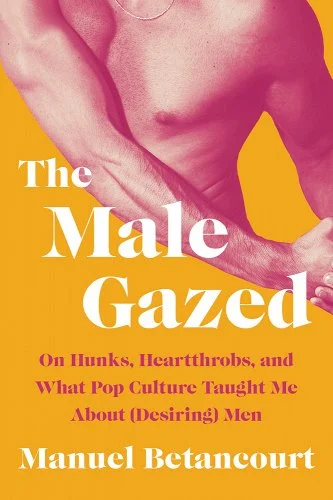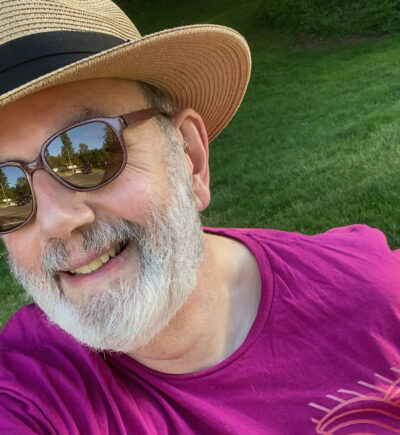Reviewed by Brian Watson
 One of the largest, unanswerable questions I have asked of myself is not, Why do I use so many commas?, but rather has to be: Why am I queer?
One of the largest, unanswerable questions I have asked of myself is not, Why do I use so many commas?, but rather has to be: Why am I queer?
Not that other people haven’t rushed to answer that question for me. Unwanted responses have ranged from the inaccurate: the tired womb theory that ascribes higher rates of homosexuality among a family’s youngest children, except I’m the eldest, swimming in the deep end of the gene pool, thank you very much. To the pathetic: college psych majors telling me that my father was too distant and my mother too close—but my father was sick for most of my childhood before dying a few months after my 14th birthday, thanks for caring. And my mother had four children to raise and I never needed helicoptering. Or from the laughable: demonic possession—who are we kidding? To the dangerous: genetics, which allows for a conservative hope that gene therapy can therefore eradicate homosexuality.
Although The Male Gazed; On Hunks, Heartthrobs, and What Pop Culture Taught Me About (Desiring) Men (Catapult 2023), a memoir-in-essays by Manuel Betancourt, doesn’t aim to answer the question of whence the author’s queerness, he does, in ten essays, examine how media and celebrities impact our own perception of our same-sex desires and identity. The question of self-perception is, from my experience, tied very closely to self-understanding, and this is why I took to this memoir eagerly, volunteering to review it.
From the very first chapter, where the discussion gleefully ricochets around Disney animation to discussions of Parker Tyler’s The Hollywood Hallucination and Gore Vidal’s Myra Breckinridge, I see glimmers of my own reflections, of seeing the desire specific to me and other queer men on screen. Betancourt writes:
“I didn’t need to have read Parker Tyler’s theories about susceptible moviegoers or have encountered Myra Breckinridge’s histrionic lectures on Hollywood’s masculine anxieties to key into the ways my erotic attraction to these animated men spoke deeply about how it is we’re trained to view men on-screen and what happens when those expectations are disrupted. I just had to find myself staring agog at, say, Beauty and the Beast’s hunk of a villain or The Little Mermaid’s silver fox of a father to see what my gaze told me about myself. After all, like Herc[ules], these were characters who looked like they’d grown out of a gay man’s wet dream. When Aurora’s Prince Philip was a waif of a lad (quite G-rated and thus better suited to my 8-year-old self), these more modern Disney men looked like they were on steroids. They were all bulging pecs and towering torsos.”
Betancourt is a few years my junior, but I experienced a similar shift in self-understanding via drawn figures, starting out with those I secretly inscribed in a giant art pad I kept hidden beneath my bed. More often than not, the men who inhabited reality were predictably heteronormative and I found myself learning more about gay ideals of beauty from comics and animations.
Near the mid-point of The Male Gazed, a chapter called “Of Capes and Men” slowly builds to a beautiful examination of the visual power of famed Puerto Rican psychic, Walter Mercado, who was known for his embrace of exquisite capes. Betancourt finds the perfect Mercado quotation to describe both Walter’s, the author’s, and even my fascination with capes: “I am the picture and the cape is my frame.” A few pages before that quoted sentence, the author describes playing Deputy Governor Thomas Danforth in a school production of Arthur Miller’s The Crucible.
“I was never one to seek the spotlight. But becoming someone else was not just comfortable, it was painfully familiar. Acting is all I did every day. I’d slowly deadened who I knew myself to me, learning to lower my voice here, hold my wrist steady there, avoid flailing while jogging here, keep my excited squeals in check there. Oh, and most importantly, playacting the part of a shy, bookish teenager who had occasional crushes on the most assuming of the girls in our class. Such performances, which remain all too familiar to queer kids then as now, are exhausting.”
The performance the author describes and the exhaustion of that performance is one I painfully remember. Although age, experience, and a little empathy has opened my eyes to the fact that more of my peers played their own roles to different extents—after all, as Ru Paul reminds us, “We’re all born naked and the rest is drag”—I want to reassert the truth of the author and extend his “then” further back in time. Queer kids have been acting straight since the invention of homosexuality as a curable disease back in the late nineteenth century.
And speaking of Ru Paul, as I am often wont to do, the last bit of The Male Gazed, a chapter entitled “A Cock in a Frock,” dives not only into Ru Paul’s Drag Race territory and the Harlem ballroom scene that indirectly birthed it, but also into a movie of great significance for me: The Adventures of Priscilla, Queen of the Desert. Shortly after moving into my Tōkyō apartment in 1994, I bought a laser-disc player and received the disc for Priscilla from a friend. I hosted performances of the film so often that, to my unending pride, Hiro, my then-boyfriend, now-husband, could quote lines of dialog. To this day, he can find precisely the right moments to intone, à la Hugo Weaving’s Mitzi, “C’mon girls. Let’s go shopping”. Or, channeling Terrance Stamp’s Bernadette, “I’ve said it before, and I’ll say it again: no more fucking ABBA”. And although I found Stamp to be somewhat strangely cast, Betancourt might convince me otherwise, even though he—rightfully—pens more about Guy Pearce, the actor who portrayed Priscilla’s christener, Felicia.
Betancourt says, “No offense to the incomparable Terence Stamp or the hilarious Hugo Weaving, the two emotional anchors of this warmhearted film. But I can’t deny that sometimes my shallowness (or horniness, more like) gets the best of me: seeing Pearce, in a black bob, wearing an outfit made entirely of pearls, was the first time I’d found myself so attracted to a drag performer. It helps that later in the film we see him wearing even less, the camera letting us admire his toned ass and abs, his bulging biceps and pecs, as he parades himself, variously, in denim cutoffs, mesh vests, chaps, sleeveless crop tops, and boxer briefs with abandon…. [Felicia], the youngest of the trio, is its most flamboyant. A swishy, bitchy muscled waif of a queen, he’s the new vanguard….”
I am drawn to this portrayal because of the way the author reminds us of what, for him and for me, lies at the kernel of drag: the coexistence of masculine and feminine, and not merely an emulation of the latter. To underline his point, the author quotes Ru Paul: “ ’My drag is less about looking like a woman,” he writes in his 2018 book, GuRu, “and more about saying F.U. to the cult of systematic masculinity I was bombarded with as a little boy.’ ”
In that way, the author and I both find that the experience of drag in media has allowed us to more fully inhabit our queer selves, both masculine and feminine, and finally, perhaps triumphantly, proud of it.
 Brian Watson has been a queer leader/mentor for more than 35 years. In addition to reviewing for Hippocampus Magazine, his craft essays appear in the BREVITY blog. White Enso selected his essay, Bending Time, for their nonfiction award. Cutbank and Columbia Journal named Unfolding, a braided essay, a finalist for their respective 2023 non-fiction contests. His writing mentor from the AWP Writer to Writer program is Garrard Conley, author of Boy Erased, and he shares his outlooks on the intersections of Japan and queerness with more than 500 subscribers to Out of Japan, his Substack newsletter.
Brian Watson has been a queer leader/mentor for more than 35 years. In addition to reviewing for Hippocampus Magazine, his craft essays appear in the BREVITY blog. White Enso selected his essay, Bending Time, for their nonfiction award. Cutbank and Columbia Journal named Unfolding, a braided essay, a finalist for their respective 2023 non-fiction contests. His writing mentor from the AWP Writer to Writer program is Garrard Conley, author of Boy Erased, and he shares his outlooks on the intersections of Japan and queerness with more than 500 subscribers to Out of Japan, his Substack newsletter.


